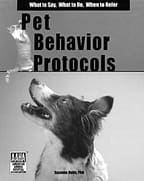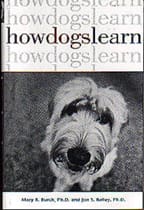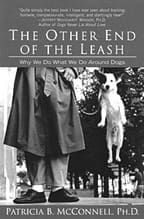Books are akin to gold for me. I’ve been an avid reader since I was a small child and learned how to “sneak read” by the glow of the hall light outside my bedroom door after lights-out time. Whenever my husband and I have moved – five times in the last 10 years – the cartons of books we’ve collected over the years have inarguably made up the bulk of our possessions.
Of course, the vast majority of our books are animal-related, and a preponderance of those are dog training and behavior books. When Nancy Kerns suggested an article highlighting WDJ’s “all-time favorites” book list, I seized the opportunity to review our collection, visit with old and new literary friends, and share with you the ones that will still inhabit my shelves when I have to pare down my collection to go live in a retirement home. If your library is missing some of these, put them on your holiday wish list, and maybe you’ll get lucky!
———-
Don’t Shoot the Dog
by Karen Pryor
Bantam Books, 1999 (revised edition)
softcover, 202 pgs; $13
Originally published in 1985, Don’t Shoot the Dog is generally regarded as the book that launched the paradigm shift from old-fashioned force-based methods to the now widely accepted positive training/clicker methods that are fast becoming the norm in the dog training industry. Ironically, it was written not as a dog-training book, but as a book on the science of behavior and learning, primarily to help people understand human behavior, secondarily dog behavior.
Pryor provides at least as many examples of using the principles to modify Homo sapien behavior as Canis familiaris applications. The cover quote by noted behavior scientist B.F. Skinner on the original edition ignores any relevance to dog training: “Karen Pryor has been a pioneer… Anyone who wants to be more effective in rearing children, teaching, or managing his or her own behavior will find her book very useful.”
Fortunately, the dog training community also discovered and embraced Pryor’s book. I am just one of a legion of positive dog trainers who owes a huge debt of gratitude to her for opening our eyes to the “why” behind the “what” of dog training, and turned our hands and leashes toward a kinder path. This is an important book to read for historical purposes, but it provides a ton of invaluable training and behavior information as well.
———-
The Other End of the Leash
by Patricia B. McConnell, Ph.D.
Ballantine Publishing Group
2002, softcover, 240 pgs; $14
I was on only the second page of the Introduction when I fell in love with this book. I read this line: “All dogs are brilliant at perceiving the slightest movement that we make, and they assume that each tiny motion has meaning.”
Of course! Yes, we all know that dogs are body-language communicators, but this one phrase brought so much into focus for me – why some of my dog owner clients have so much difficulty communicating with their dogs (their body language is “all over the place”) while others are just naturals and immediately seem to get it. Not coincidentally, so do their dogs.
The Other End of the Leash is a book about us – the human primate – and how we behave with our dogs. McConnell explains the differences between innate primate behavior (us) and canine behavior, and why so many of the things we do so naturally, like patting dogs on the head, hugging them, and kissing them on the nose, are so aversive to many dogs. With gentle humor and intriguing insights, she helps the reader to a far better understanding of the canine psyche, and enables us to improve and strengthen our relationships with our canine companions.
McConnell is a gifted writer – her talent lies in taking things that you may already know in your head and helping you see it in your heart. Her books are entertaining and highly readable and always contain multiple pearls of wisdom. While The Other End of the Leash is my favorite McConnell book, anything she’s written is worthy of space on your shelves.
———-
The Culture Clash
by Jean Donaldson
James & Kenneth Publishing, 2005 (2nd ed)
softcover, 203 pgs; $18
Originally published in 1996, The Culture Clash is a delightful reality sandwich for dog lovers. I remember sitting down with this book, and time and again leaping from my chair shouting, “Yes! Yes!” as I read Donaldson’s sometimes biting commentary as she describes, in no uncertain terms, why dogs are sometimes so misunderstood – and badly behaved as a result – and how to help them be better.
The Culture Clash opens by debunking the myth of the Walt Disney Dog. Donaldson makes it clear that it’s unfair to expect dogs to be perfect, much less to understand or subscribe to a human moral code. In fact, in order to make our dogs behave more appropriately in our alien (to them) human culture, the author insists we have to understand them, accept them for who they are, and make greater accommodations to meet their needs while we expect them to meet ours.
Donaldson’s sharp wit keeps this an entertaining read to the last page. If some of her arrows sting a little, it may be time for some gentle self-examination. I wouldn’t expect too many arrows to hit close to home for educated WDJ readers!
———-
Dr. Dunbar’s Good Little Dog Book
by Dr. Ian Dunbar
James & Kenneth Publishing, 2003 (3rd ed)
softcover, 139 pgs; $18
Dr. Dunbar is the catalyst for the growth of positive puppy training in this country over the past 15 years, as well as the founder of the Association of Pet Dog Trainers, which now boasts more than 4,000 members. He’s also a prolific and entertaining writer.
Although any of Dunbar’s books offer loads of useful information, this one, originally published in 1992, is particularly engaging, thanks to the profusion of quality color photos that illustrate the accompanying exercise descriptions. While the book was designed to accompany two of his training videos, it does perfectly well all on its own as a guide to training the companion dog.
In addition to basic good manners exercises, Dr. Dunbar’s Good Little Dog Book offers valuable information on socialization, bite inhibition, and general household etiquette. It’s an inviting, easy-to-read, easy-to-follow book that makes a perfect gift for your first-time dog-owning friends.
———-
Click for Joy!
by Melissa C. Alexander
Sunshine Books, Inc., 2003
softcover 208 pgs; $25
Click for Joy! is a delightful book for dog owners and trainers who are taking their first leap into clicker training, as well as those who are ready to move beyond basic clicking. It’s presented in a question and answer format, and comprised of a comprehensive collection of questions Alexander answered on her online “Clicker Solutions” discussion list. These range from the very simple (“What is clicker training?”) to the more advanced (“What is a keep-going signal,” and “What is ‘fluent’ and how do I get there?”).
From good manners training and solving behavior problems to the scientific principles behind the clicker, if you have a question about clicking, chances are good the answer is in Click for Joy! What a great resource!
———-
How Dogs Learn
by Mary R. Burch, PhD, and Jon S. Bailey, PhD
Howell Book House, 1999, hardcover
188 pgs; $20
Once upon a time, the scientific principles of behavior and learning were presented in daunting volumes fraught with jargon and page after page of incomprehensible formulas of strange-looking letters, using examples of rats in Skinner boxes. Burch and Bailey’s book changed all that by offering the information in understandable, everyday language, with training examples that actually use dogs.
How Dogs Learn is an excellent read – a perfect choice for dog owners who want to understand the “hows” and “whys” as well as the “whats” of dog training.
We especially love the authors’ positive lean in a scientifically based book. Many Ph.D. behaviorists appear unwilling to take a strong stand against the use of positive punishment. While Burch and Bailey stop short of saying they would never use a shock collar, they make it refreshingly clear that their very strong preference is for the use of non-coercive methods that encourage a relationship of trust between dog and human.
———-
Coaching People to Train Their Dogs
by Terry Ryan
Legacy Canine, 2005
softcover, 404 pgs; $65
Terry Ryan, long a leader in positive training, has provided a number of excellent books on the subject, but she has outdone herself with this one. Intended to help trainers offer top quality training classes, this outstanding volume also has much to offer the dedicated dog owner.
The large volume is set up to mirror the topics covered by the Pet Dog Trainer Certification exam, including an overview of the current state of the dog training industry, a comprehensive section on dog behavior, another on the science of learning, business and people skills, and class organization and teaching, closing with an excellent chapter on solving behavior problems that reprises her book, Toolbox for Remodeling Problem Dogs.
I often receive pleas from dog owners who can’t find a good trainer near them, and are looking for a self-help guide to training their dogs using positive methods. Ryan’s book is a great resource for this, especially the sections on teaching classes. Ryan offers several options with clear instructions for training each of the exercises, as well as fun games, homework assignments, and other activities that a teacherless dog owner could apply in a home training program. It’s a pricey book, but it contains a wealth of information.
———-
Pet Behavior Protocols
by Suzanne Hetts, PhD
American Animal Hospital Association, 1999 (2nd ed)
softcover, 322 pgs; $82
Hetts’ book aims at a more professional audience than most of the previous books on our list. It is written specifically for the pet behavior consultant, and provides excellent information to guide the consultant in the creation and implementation of step-by-step behavior modification protocols for a wide range of problem behaviors. The protocols can also be useful for the dog owner who is having difficulty locating a qualified behavior professional in their community.
There are a growing number of behavior consultants in the country and while some are certified by the International Association of Animal Behavior Consultants, many are not, and vary in their experience, skills, and capabilities. There are even fewer Certified Applied Animal Behaviorists (veterinarians or Ph.D. behaviorists) – about 40 in the entire country, and not all of them actively practice. This book can help fill the gap.
Pet Behavior Protocols is an excellent resource for knowledgeable owners working through behavior problems on their own, behavior consultants wishing to bolster their knowledge and protocols, and owners who need more information to help them gauge the knowledge and abilities of the behavior professional they’re considering engaging to help them with their dogs.
———-
Clinical Behavioral Medicine for Small Animals
by Karen Overall, MA, VMD, PhD
Mosby – Year Book, Inc., 1997
softcover, 544 pgs; $70
I owe a huge debt of gratitude to the Santa Cruz veterinarian friend who introduced me to this book. It’s an incredibly valuable resource, presenting behavior problem analysis and modification in a scientific, unemotional yet very readable style. Written for veterinarians who wish to be more knowledgeable about behavior in their daily clinical practices, it’s also a terrific tool for non-veterinary behavior consultants as well as the dog owner who wishes to be better educated than the average human about dog behavior and behavior modification.
This book is not for light bedtime reading – it’s dense with information. Overall is a brilliant veterinary behaviorist, and one of the few I know who is willing to stand up in public, as she did at the 2003 APDT conference, and state that in her opinion there is no need, ever, to use a shock collar on a dog in the name of training. She has been promising a next book for the past few years; we’re eagerly awaiting its arrival.
———-
Handbook of Applied Dog Behavior and Training
(Volumes 1-3)
by Stephen R. Lindsay
• Volume 1: Adaptation and Learning (Iowa State University Press, 2000, hardcover, 410 pgs; $80)
• Volume 2: Etiology and Assessment of Behavior Problems (Iowa State University Press, 2001, hardcover, 328 pgs; $60)
• Volume 3: Procedures and Protocols (Blackwell Publishing, 2005, hardcover, 795 pgs; $100)
If I were stranded on a desert island, along with Patricia McConnell’s The Other End of the Leash, I would want Lindsay’s three-volume set of works by my side. Of course, I’m a dog behavior and training fanatic – but I’ll bet a lot of you are, too!
These books are college textbook-dense and serious, containing absolutely everything you could ever possibly want to know about dog behavior and training – and then some. Not for the faint of heart, Lindsay’s works are written for the serious student of dog behavior and learning, and as such are an invaluable resource. They are thoroughly indexed, making it a reasonably simple matter to research the topic of the moment without having to page through volumes of unrelated material.
If you’d like to have an encyclopedic-type reference for your dog-training library, head for Lindsay. It may take you years to wade through them, but you’ll be amazed at the depth of information he offers.










